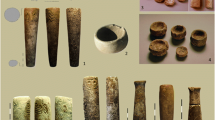Abstract
Instrumental neutron activation analysis of small flakes from the same flint fragment of archeological artefacts from Palaeolithic sites (“Abrigo de la Quebrada”, “Cova de les Cendres” and “Cova Negra”), and geological sources (Chelva, Valencia, and Alcoi, Alicante) from the eastern Spain, was performed. The chemical contents of 27 elements were obtained. Ga, Ce, Nd, Yb, Zr and Hf were discarded due to high variations within the same fragment. The identification of chemical fingerprints within heterogeneous flint fragments was able to differentiate flint types and variants (“Domeño” and “Serreta”), contributing to provenance and human mobility in ancient times.




Similar content being viewed by others
References
Malyk-Selivanova N, Ashley GM, Gal R, Glascock MD, Neff H (1998) Geological-geochemical approach to “sourcing” of prehistoric chert artefacts, Brooks Range, Northwest Alaska. Geoarchaeology 13:673–708
Costopoulos A (2003) Prehistoric flint provenance in Finland: reanalysis of southern data and initial results for the north. Fennoscandia Archaeol 20:41–54
Allard P, Bostyn F, Gilignay F, Lech J (2008) Flint mining in prehistoric Europe: interpreting the archaeological records, vol 1891., British Archaeological Reports International SeriesArchaeopress, Oxford
Bustillo MA, Castañeda M, Capaote M, Consuegra S, Criado C, Díaz-del-Río P, Orozco T, Pérez-Giménez JL, Terradas X (2009) Is the macroscopic classification of flint useful? A petroarchaeological analysis and characterization of flint raw materials from the Iberian Neolithic mine of Casa Montero. Archaeometry 51:175–196
Hughes RE, Högberg A, Olausson D (2010) Sourcing flint from Sweden and Denmark: a pilot study employing non-destructive energy dispersive X-ray fluorescence spectrometry. J Nordic Archaeol Sci 17:15–25
Hughes RE, Högberg A, Olausson D (2012) The chemical composition of some archaeologically significant flint from Denmark and Sweden. Archaeometry 54(2012):779–795
Shackley MS (2011) X-ray fluorescence spectrometry (XRF) in Geoarchaeology. Springer, New York
Gauthier G, Burke AL, Leclerc M (2012) Assessing XRF for the geochemical characterization of radiolarian chert artefacts from northeastern North America. J Archaeol Sci 39:2436–2451
Crandell ON (2008) Regarding the procurement of lithic materials at the Neolithic site at Limba (Alba County, Romania): sources of local and imported materials. In: Kostov RI, Gaydarska B, Gurova M (eds) Geoarchaeology and archaeomineralogy., Proceedings of the international conference, 29–30, SofiaSt Ivan Rilski, Sofia, pp 36–45
Menargues J (2005) La explotación de las rocas locales en los yacimientos paleolíticos de la Ratlla del Bubo (Crevillent, Alicante) y la Cova de les Cendres (Teulada, Alicante). In: Santonja M, Pérez-González A, Machado MJ (eds) Geoarqueología y Patrimonio en la Península Ibérica y el entorno mediterráneo, Adema Patrimonio. Almazán, Soria, pp 413–424
Villaverde V, Eixea A, Zilhão J (2008) Aproximación a la industria lítica del Abrigo de la Quebrada (Chelva, Valencia). Treballs Arqueologia 14:213–228
Eixea A, Villaverde V, Zilhão J (2011) Aproximación al aprovisionamiento de materias primas líticas en el yacimiento del Paleolítico medio del Abrigo de la Quebrada (Chelva, Valencia). Trab Prehist 68:65–78
Tiffagom M (2006) De la Pierre à l’Homme. Essai sur une paléoanthropologie solutréenne, Eraul. Université de Liège, Service de Prehistoire, Liège
Molina JA, Tarriño A, Galván B, Hernández M (2010) Áreas de aprovisionamiento de sílex en el Paleolítico medio en torno al Abric del Pastor (Alcoi, Alicante). Estudio macroscópico de la colección Brotons. Recerques Museu d’Alcoi 19:65–80
Eixea A, Roldán C, Villaverde V, Zilhão J (2014) Middle Palaeolithic flint procurement in Central Mediterranean Iberia: Implications for human mobility. J Lithic Studies 1:103–115
Roldán C, Carballo J, Murcia S, Eixea A, Villaverde V, Zilhão J (2015) Identification of local and allochthonous flint artefacts from the Middle Palaeolithical site ‘Abrigo de la Quebrada’ (Chelva, Valencia, Spain) by macroscopic and physicochemical methods. X-Ray Spectrom. doi:10.1002/xrs.2602
Prudêncio MI, Oliveira F, Dias MI, Sequeira Braga MA, Delgado M, Martins M (2006) Raw materials identification used for the manufacture of Roman “Bracarense” ceramics from NW Iberian Peninsula. Clays Clay Miner 54:639–651
Sanjurjo-Sánchez J, Trindade MJ, Blanco-Rotea R, Benavides Garcia R, Fernández Mosquera D, Burbidge CI, Prudêncio MI, Dias MI (2010) Chemical and mineralogical characterization of historic mortars from the Santa Eulalia de Bóveda temple, NW Spain. J Archaeol Sci 37:2346–2351
Prudêncio MI, Cabral JMP (1988) Rare earths and other trace elements in cretaceous clays from central Portugal. J Radioanal Nucl Chem 123:309–320
Govindaraju K (1994) Compilation of working values and sample description for 383 geostandards. Geostand Newsl 18:1–158
Dung HM, Freitas MC, Santos JP, Marques JM (2010) Re-characterization of irradiation facilities for k0-NAA at RPI after conversion to LEU fuel and rearrangement of core configuration. Nucl Instrum Methods Phys Res A622:438–442
Fernandes AC, Santos JP, Marques JG, Kling A, Ramos AR, Barradas NP (2010) Validation of the Monte Carlo model supporting core conversion of the Portuguese Research Reactor (RPI) for neutron fluence rate determinations. Ann Nucl Energy 37:1139–1145
Gouveia MA, Prudêncio MI, Morgado I, Cabral JMP (1992) New data on the GSJ reference rocks JB-1a and JG-1a by instrumental neutron activation analysis. J Radioanal Nucl Chem 158:115–120
Statsoft, Inc. (2013) Statistica (data analysis software system), version 12. http://www.statsoft.com
Acknowledgments
The authors deeply appreciate the valuable comments and suggestions of the anonymous reviewers. This project was developed with funds of the research project PROMETEOII/2013/016 from the Generalitat Valenciana and the research projects HAR2011-24878 and HAR2014-52671 from the Ministerio de Ciencia e Innovación. Grateful acknowledgements are also made to all the staff of the Portuguese Research Reactor (RPI) of CTN/IST for their assistance with the neutron irradiations. C2TN/IST authors gratefully acknowledge the FCT (the Portuguese Science and Technology Foundation) support through the UID/Multi/04349/2013 project.
Author information
Authors and Affiliations
Corresponding author
Rights and permissions
About this article
Cite this article
Prudêncio, M.I., Roldán, C., Dias, M.I. et al. A micro-invasive approach using INAA for new insights into Palaeolithic flint archaeological artefacts. J Radioanal Nucl Chem 308, 195–203 (2016). https://doi.org/10.1007/s10967-015-4294-z
Received:
Published:
Issue Date:
DOI: https://doi.org/10.1007/s10967-015-4294-z




